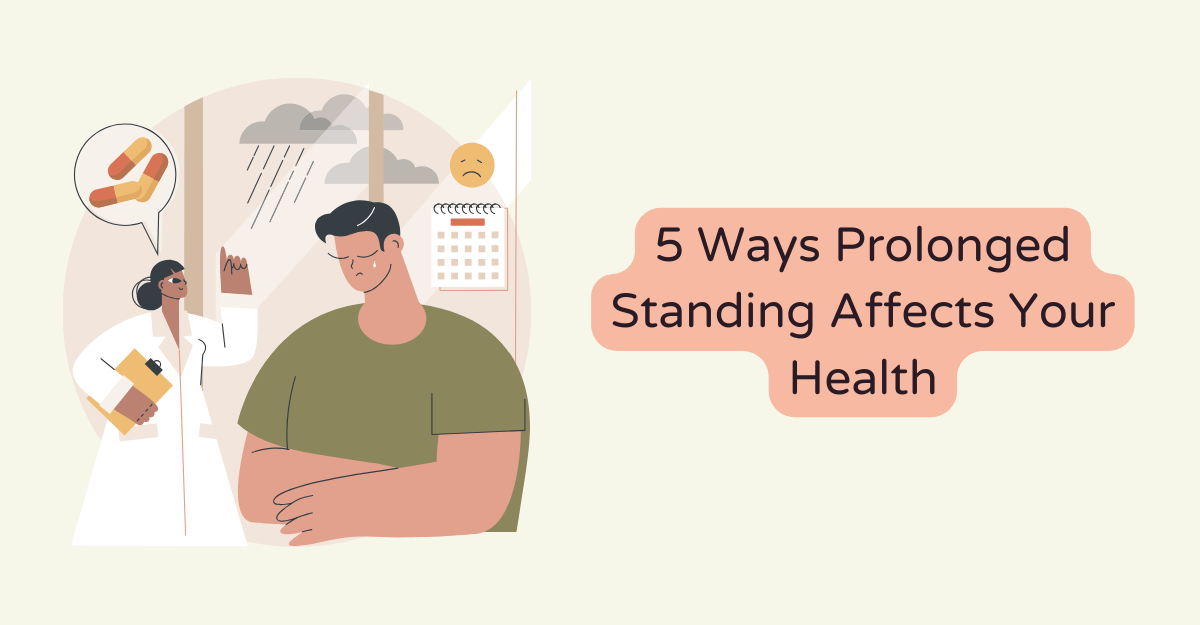
5 Ways Prolonged Standing Affects Your Health
Long periods of standing are a regular part of many jobs and everyday activities, yet they can have negative effects on one’s general health and well-being. This article will discuss five ways that standing for extended periods can harm your health, ranging from joint and cardiovascular issues to an increased chance of varicose veins. People may take proactive measures to reduce the dangers and promote improved general health and comfort by being aware of these possible health effects.
Increased Risk of Varicose Veins
Long periods of standing can impair leg circulation, which raises the possibility of varicose veins forming. The veins in the lower extremities have become harder to pump oxygen back to the heart against gravity when standing for lengthy periods. Varicose veins can form because of this tension over time, which can make the veins enlarged, twisted, and apparent beneath the skin. People who stand for extended periods at work or while going about their daily business should take frequent breaks to raise their legs and enhance circulation, which lowers the risk of developing varicose veins. Because nutrition and exercise are lifestyle variables that can potentially lead to vein insufficiency and the development of varicose veins, it is essential to pay attention to these aspects.
Foot and Leg Pain
Standing for extended periods can place too much strain on the legs and feet, which can cause pain and discomfort. Conditions including plantar fasciitis, Achilles tendinitis, and shin splints can be brought on by the continuous tension placed on the ligaments, tendons, and muscles in the lower extremities. Long lengths of time spent standing on hard surfaces can also aggravate foot discomfort and hasten the onset of diseases like falling arches or flat feet, especially in urban environments like Manhattan. Leg and foot discomfort brought on by extended standing can be reduced by doing foot-strengthening exercises, utilizing anti-fatigue mats, and donning supportive gear. In order to avoid persistent problems that might affect mobility and general quality of life, it is important to treat foot and leg pain, and seeking specialized care from doctors who know a lot about plantar fasciitis in Manhattan can provide tailored solutions to enhance recovery and prevent recurrence.
Lower Back Pain
Prolonged standing in a static posture can cause stiffness and soreness in the lower back. Extended periods of standing can wear down and strain the lower back muscles, resulting in discomfort, tension, and stiffness. Slouching or bending forward when standing might be a bad posture that makes lower back discomfort worse. Having supportive shoes, adopting ergonomic workspaces, and maintaining good posture can all help lessen the risk of back pain brought on by extended standing. Frequent workouts that target the back and core muscles for strengthening and flexibility can also relieve pain and stop it from returning.
Joint Problems
Prolonged standing can put an undue amount of strain on the joints, especially the ankles, hips, and knees. This elevated pressure over time may aggravate joint conditions such as bursitis, tendinitis, and osteoarthritis. Prolonged standing can cause the afflicted joints to become stiff, stiffen, and lose some of their range of motion. Regular stretching, keeping an appropriate weight, and wearing supportive, well-cushioned footwear can all help reduce the risk of joint issues brought on by extended standing. Suppose you have chronic joint pain or discomfort. In that case, it’s critical to pay heed to your body’s signals and consult a doctor to avoid aggravating the situation and worsening the condition of your joints.
Increased Risk of Cardiovascular Issues
Standing for an extended period can be harmful to cardiovascular health, especially for people who already have heart disease or hypertension. Long durations of standing can cause blood to gather in the lower limbs, which can worsen circulation and put greater pressure on the heart. Conditions including deep vein thrombosis (DVT), coronary artery disease, and stroke may arise as a result of this. Wearing compression stockings, drinking plenty of water, and taking periodic breaks to sit or walk can all assist in enhancing circulation and lower the risk of cardiovascular problems brought on by extended standing. Those who have underlying cardiovascular issues should speak with their healthcare practitioner for specific advice on how to manage the negative impact of extended standing on their cardiovascular system.
Conclusion
Many vocations and daily activities include standing, so it’s important to be aware of the possible health risks connected to extended standing. People may lessen the detrimental effects on their health and wellbeing by putting techniques like taking regular breaks, wearing supportive footwear, and maintaining good posture into practice. Even in circumstances when extended standing is necessary, making self-care a priority and paying attention to your body’s cues may help to promote comfort and preserve maximum health.






